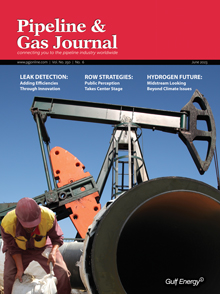
June 2023, Vol. 250, No. 6
Editor's Notebook
(P&GJ) — The movie "How to Blow Up a Pipeline" tells a fictional story set in West Texas, where a group of people from different walks of life band together for various reasons and decide to blow up a pipeline. You already know the muddled thinking behind arriving at this decision – you've heard it before.
Features
(P&GJ) — The energy transition and climate targets have created a pressing need to scale technologies to decarbonize hard-to-abate sectors, many of which require low-carbon gases as well as greater electrification.
(P&GJ) — Looking back two decades when actor-turned-politician Arnold Schwarzenegger was governor of California, stakeholders in the nation’s most populous state were talking about creating a “Hydrogen Highway” for alternative fueled transportation.
(P&GJ) — Four years after part one of the PHMSA Mega Rule came into effect, the industry is still trying to get a handle on the full extent of the rule requirements and their implications.
(P&GJ) — Pipelines are incredibly valuable assets for the energy and resources industry. Not only are they the safest way to move petroleum and other products, but they are also the most cost-effective and sustainable option to do so.
(P&GJ) — Decarbonization is a critical challenge facing the world today, and the expansion of renewable energy sources is a key component of addressing this challenge. In the face of changing corporate and public goals with regards to the low-carbon energy transition and changing energy landscape, many companies are looking for opportunities to support more sustainable forms of energy.
(P&GJ) — The selection of appropriate pipeline routes is critical for reducing the impact of geotechnical and hydrotechnical hazards. Many hazards, including water crossings, can be avoided by careful route planning.
(P&GJ) — Pipeline infrastructure and operations raise two common concerns among landowners and other public entities: greenhouse gas (GHG) emissions and ecosystem disturbance.
(P&GJ) — When a pipeline operator becomes a “common carrier” under Texas law, it is granted the power of eminent domain over private property for public use. Texas law provides two independent sources for common carrier status: Texas Natural Resources Code Section 111 and Texas Business Organizations Code Section 2.105. Common carrier status is critical to pipeline projects in Texas, especially when easements are difficult to obtain.
(P&GJ) — Engineering Critical Assessments (ECA) have been incorporated into United States pipeline safety regulations1 as a means for reconfirming the maximum allowable operating pressure (MAOP) for onshore steel gas transmission pipelines, while engineering assessments (EA) have been a longstanding method for proving consistent conclusions and recommendations across a variety of situations in accordance with the guidance in Canadian standard CSA Z662:19.
Tech Notes
(P&GJ) — Evaluation of a facility, based in the north of Thailand, found that a huge pipeline carrying high-pressure water for injection into oil wells was suffering from thin wall defects. The pipeline in question was made out of 39-foot (12-meter) pipe lengths that had been welded together.
(P&GJ) — Decom Engineering’s specialized cutting technology has been successfully deployed on a decommissioning project off the coast of West Africa.
Projects
(P&GJ) — Nigeria has completed 70% of its 384-mile AKK gas pipeline; Kinder Morgan has launched a binding open season for the expansion of its SFPP pipeline; Sinopec has announced plans to build a 259-mile hydrogen pipeline in Mongolia; Peninsula Pipeline has finished its natural gas expansion project in Florida; and more in the latest issue of P&GJ's Project Update.
Guest Perspective
(P&GJ) — Russia is looking to build on its energy ties with China, a key buyer of its gas. But Beijing’s position of power in the relationship may mean the sanctioned producer is in no rush to complete new projects, especially the much-discussed Power of Siberia 2 pipeline.

- Keystone Oil Pipeline Resumes Operations After Temporary Shutdown
- Freeport LNG Plant Runs Near Zero Consumption for Fifth Day
- Biden Administration Buys Oil for Emergency Reserve Above Target Price
- Mexico Seizes Air Liquide's Hydrogen Plant at Pemex Refinery
- Enbridge to Invest $500 Million in Pipeline Assets, Including Expansion of 850-Mile Gray Oak Pipeline



